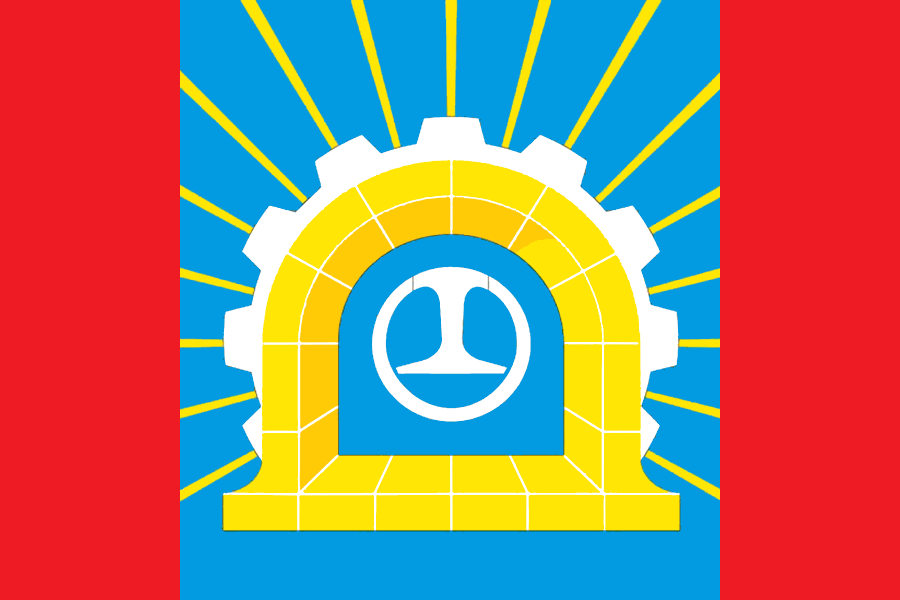
Shcherbinka is a town, formerly in Moscow Oblast, Russia, and since July 1, 2012 a part of the federal city of Moscow, Russia. It is located 37 kilometers (23 mi) south of the center of Moscow. Population: 32,450 (2010 Census); 28,043 (2002 Census); 28,011 (1989 Census).

Begovoy District is an administrative district (raion) of Northern Administrative Okrug, and one of the 125 raions of Moscow, Russia. The area of the district is 4.18 square kilometers (1.61 sq mi). Population: 37,900

Beskudnikovsky District is an administrative district (raion) of Northern Administrative Okrug, and one of the 125 raions of Moscow, Russia. The district is about 12 km north of Central Moscow, and has an area of 3.27 square kilometers (1.26 sq mi). Population: 64,000

Severnoye Tushino District or Northern Tushino is an administrative district (raion) of North-Western Administrative Okrug, and one of the 125 raions of Moscow, Russia. In the district there are Alyoshkinsky forest and Severnoye Tushino park.

Yuzhnoye Tushino District is an administrative district (raion) of North-Western Administrative Okrug, and one of the 125 raions of Moscow, Russia.
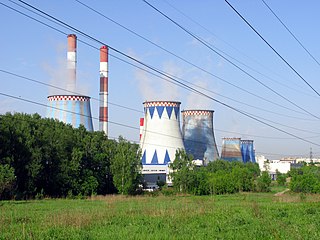
Metrogorodok District is the northernmost administrative district (raion) of Eastern Administrative Okrug, and one of the 125 raions of Moscow, Russia. The district has a size of 27.57 square kilometers (10.64 sq mi).

Severnoye Izmaylovo District is one if 16 districts in the administrative district (raion) of Eastern Administrative Okrug, and one of the 125 raions of Moscow, Russia. It is bounded on the north by Shchelkovo Highway, on the south by Sirenevyy Boulevard, and on the east by the Moscow Ring Road (MKAD). The area of the district is 4 square kilometers (1.5 sq mi). Population: 85741 ;
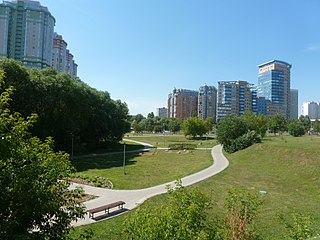
Troparyovo-Nikulino District is an administrative district (raion) at the southern edge of Western Administrative Okrug, and one of the 125 raions of Moscow, Russia. The western border is the Moscow Ring Road, and the southern border is Leninsky Prospekt. The area of the district is 11.26 square kilometers (4.35 sq mi). Population: 119,000

Chertanovo Yuzhnoye District is an administrative district (raion) of Southern Administrative Okrug, and one of the 125 raions of Moscow, Russia.
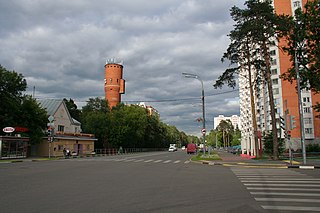
Nekrasovka District is an administrative district (raion) of South-Eastern Administrative Okrug, and one of the 125 raions of Moscow, Russia. The area of the district is 11.475 square kilometers (4.431 sq mi). Population: 68,539

Nizhegorodsky District is an administrative district (raion) of South-Eastern Administrative Okrug, and one of the 125 raions of Moscow, Russia. The area of the district is 7.574 square kilometers (2.924 sq mi). Population: 32,000.

Ryazansky District, Moscow is an administrative district (raion) of South-Eastern Administrative Okrug, and one of the 125 raions of Moscow, Russia. The area of the district is 6.485 square kilometers (2.504 sq mi).

Vykhino-Zhulebino District is an administrative district (raion) of South-Eastern Administrative Okrug, one of the 125 raions of Moscow, Russia. The area of the district is 14.77 square kilometers (5.70 sq mi). Population: 219,600.

Konkovo District is an administrative district (raion) of South-Western Administrative Okrug, and one of the 125 raions of Moscow, Russia. The area of the district is 7.179 square kilometers (2.772 sq mi). Population: 97,847 .It is located in the south of the city, along the orange metro line.

Kotlovka District is an administrative district (raion) of South-Western Administrative Okrug, and one of the 125 raions of Moscow, Russia. The area of the district is 3.865 square kilometers (1.492 sq mi). Population: 54,200.
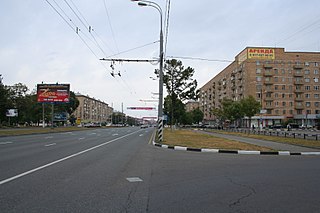
Lomonosovsky District, Moscow is an administrative district (raion) of South-Western Administrative Okrug, and one of the 125 raions of Moscow, Russia. The area of the district is 3.34 square kilometers (1.29 sq mi). Population: 85,000 . Population - 81,851. Established at 1995. Named after Mikhail Vasilyevich Lomonosov.

Severnoye Butovo District is an administrative district (raion) of South-Western Administrative Okrug, and one of the 125 raions of Moscow, Russia. The area of the district is 9.271 square kilometers (3.580 sq mi). Population: 73,357.

Bulvar Admirala Ushakova is a station on the Butovskaya Line of the Moscow Metro system in Moscow, Russia. It was opened on 27 December 2003 along with four other stations. The station is located in Yuzhnoye Butovo District, between two other stations of the same line, Ulitsa Skobelevskaya and Ulitsa Gorchakova. The station, which name literally means Admiral Ushakov Boulevard, was named after the nearby street, and the street was named after the 18th-century Russian naval commander Fyodor Ushakov.

Ulitsa Gorchakova is a station on the Butovskaya Line of the Moscow Metro system in Moscow, Russia. It was opened on 27 December 2003 along with four other stations. The station is located in Yuzhnoye Butovo District, between two other stations of the same line, Bulvar Admirala Ushakova and Buninskaya Alleya.




























